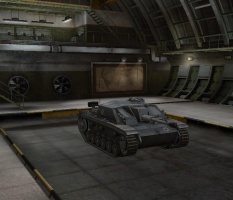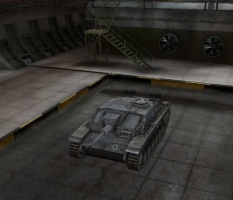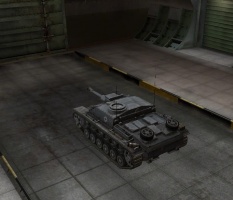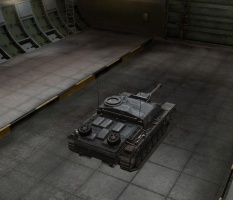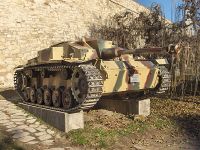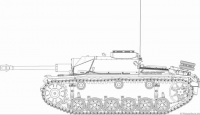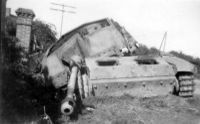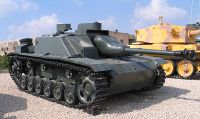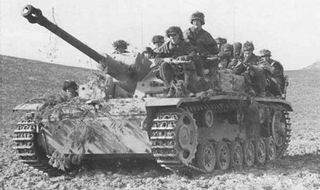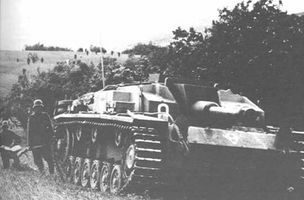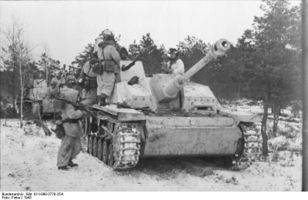StuG III Ausf. G
<value_unset_error>
Mouse over "
[Client Values; Actual values in
| 0 |
| health Hit Points |
| 0/0Expression error: Unexpected < operator./0 t Weight Limit |
| engine Engine Power |
| / km/h Speed Limit |
| traverse Traverse |
| Expression error: Unexpected < operator.Expression error: Unexpected < operator. hp/t Power/Wt Ratio |
| NoNo Pivot |
| // mm Hull Armor |
| //// mm Turret Armor |
| //// HP Damage |
| //// mm Penetration |
|
Expression error: Unexpected < operator. r/m ▲
Expression error: Unexpected < operator. r/m Standard Gun ▲ Rate of Fire Standard Gun |
|
Expression error: Unexpected * operator. ▲
Expression error: Unexpected * operator. Standard Gun
▲ Damage Per Minute Standard Gun
|
|
Expression error: Unexpected round operator. m ▲
Expression error: Unexpected round operator. m With 50% Crew: Expression error: Unexpected < operator. m ▲ Accuracy With 50% Crew: Expression error: Unexpected < operator. m |
|
Expression error: Unexpected round operator. s ▲
Expression error: Unexpected round operator. s With 50% Crew: Expression error: Unexpected < operator. s ▲ Aim time With 50% Crew: Expression error: Unexpected < operator. s |
| turretTraverse Turret Traverse |
| 0° Gun Arc |
| -°/+°-°/+° Elevation Arc |
| ammo Ammo Capacity |
| Expression error: Unexpected * operator.Expression error: Unexpected * operator. % Chance of Fire |
|
m ▲
m With 50% Crew: Expression error: Unexpected < operator. m ▲ View Range With 50% Crew: Expression error: Unexpected < operator. m |
|
m ▲
m With 50% Crew: Expression error: Unexpected < operator. m ▲ Signal Range With 50% Crew: Expression error: Unexpected < operator. m |
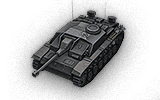
0
The <value_unset_error> is a [[|]] tier .
<value_unset_error>
The StuG III G is exceptionally maneuverable, being based on the Pz.Kpfw. III chassis -- it can rotate 360° like a medium tank and can reach its top speed very quickly. While its stock cannon is powerful against equal-tier opponents it is rendered useless against anything past Tier VI. However once upgraded with the 7.5cm Pak 42 L/70 gun the StuG III can deal significant damage to higher-tier vehicles. It's easy to fall into the trap of thinking you're a medium tank with the StuG III's rapid acceleration and high maneuverability, but you'll soon learn that you cannot take hits like a medium tank. In fact the StuG can easily die even to Tier III opponents if they find a way to attack its sides. Even so, experienced players will enjoy running the "StuG life" in this powerful sniper.
The <value_unset_error> marks the end of its line.
Modules / Available Equipment and Consumables
Player Opinion
Pros and Cons
Pros:
- Superb firepower and accuracy
- Excellent acceleration and maneuverability
- Very good camo rating
- Reasonable front armour that can bounce shots if they hit the sloped portions
Cons:
- Low view range, Optics or Binocs are recommended
- Horrible reverse speed makes it harder to get out of a bad situation
- Somewhat low ammo capacity coupled with the high fire rate with top gun -- only 44 rounds
- Poor side and rear armour -- flat and thin, along with very weak lower frontal glacis
- Terrible dispersion while on the move
- Engine can be damaged easily if the lower plate is hit
Performance
The StuG III G is an absolute nightmare to opponents if used correctly. It can be both a close combat unit with the inaccurate, hard hitting 10.5cm, or can be an excellent sniper with the 7.5cm Pak 42 L/70 -- the exact same Tier VI gun found on the E 25 but with two-thirds the rate of fire and a bit worse aim time and accuracy (but still excellent) and the same penetration values. The 10.5cm can be just as good for taking out lower-tiered enemies in one shot but it is not as useful against higher-tiered tanks.
But the true strength of this StuG lies in its sniping attributes -- insane camo, accuracy, and aim time. Therefore it is highly recommended to use the 7.5cm and to buy a camo net or low noise exhaust. With the Tank Gun Rammer and the Enhanced Gun Laying Drive along with 100% crew with camo and repair as secondary perks combined with hiding in a bush, this tank is virtually invisible, even when firing. Adding binoculars to further increase sniping ability is recommended. Sniping from afar you'll often get many opportunities at the sides and rears of tanks. Even against many Tier VII tanks the top 7.5cm cannon will still be able to defeat its targets frontally.
Being based on the Panzer III's chassis, the StuG III G can dart around the battlefield. Use this speed to stay far from combat and relocate efficiently. Use your gun to take out the tanks your allies are having trouble with; your gun's high penetration can shear through nearly any tank if aimed correctly. If the tables turn on you and there's nowhere to run, don't be afraid to engage in close-quarters combat, since your high maneuverability can keep up with a flanker. Even so your low armor and HP will be your bane, so in general keep to sniping.
Care must be taken when firing with this vehicle, as it has a low ammunition capacity of 44 rounds (buffed from 36). Coupled with its high rate of fire and low damage per round, running out of ammunition is a real possibility.
Important to note is that in contrast to the StuG III's good forward acceleration and maneuverability, its reverse speed is very slow, a problem when trying to move back from enemy fire. Make sure you have a well-defended position with an escape route, otherwise your enemies will be very happy to pay back what you've done to them. Adding a turbocharger should be considered for the extra reverse speed and acceleration.
Early Research
- The 7.5cm PaK 39 L/48 and 10.5cm StuH 42 L/28 guns carry over from the Hetzer, but the 10.5cm is too heavy for the stock suspension
- If you played the Pz.Kpfw. III Ausf. A or the Pz.Kpfw. IV previously, the Maybach HL 120 TRM engine will already be unlocked as well as the FuG 7 radio
- Research the upgraded suspension first for additional weight capacity and a seven deg/s increase to traverse speed. Neither of the above 7.5cm cannon have enough penetration to deal with higher-tiered opponents, so install the 10.5cm howitzer and use HE ammunition (or not, HE rounds were nerfed and now considered unreliable)
- Research the 7.5cm L/70 gun for superior firepower
- Go from there
It's recommended that you research the suspension and engines first; this will allow you to outmaneuver most tanks on your tier, be it in order to flee or to keep them in front of you during a close range dogfight. After the suspension and engines are mounted you should head towards the L/70 for higher penetration and accuracy. Until this high-performance weapon is available you should consider using the 10.5cm howitzer.
Suggested Equipment
![]()
![]()
![]()
![]() Low Noise Exhaust SystemTurbocharger
Low Noise Exhaust SystemTurbocharger
Gallery
Historical Info
The Sturmgeschütz III (StuG III) assault gun was Germany's most produced armored fighting vehicle during World War II. It was built on the chassis of the proven Panzer III tank. Initially intended as a mobile, armored light gun for infantry support, the StuG was continually modified and widely employed as a tank-destroyer.
Development
The Sturmgeschütz III originated from German experiences in World War I, when it was discovered that during the offensives on the western front the infantry lacked the means to effectively engage fortifications. The artillery of the time was heavy and not mobile enough to keep up with the advancing infantry to destroy bunkers, pillboxes, and other minor obstacles with direct-fire. Although the problem was well-known in the German army it was General Erich von Manstein, who is considered the father of the Sturmartillerie, that saw the solution. The initial proposal was from (then) Colonel von Manstein, and submitted to General Ludwig Beck in 1935, suggesting that Sturmartillerie ("assault artillery") units should be used in a direct-fire support role for infantry divisions. On June 15, 1936 Daimler-Benz AG received an order to develop an armored infantry-support vehicle capable of mounting a 75mm (2.95 in) artillery piece. The gun mount's fixed, fully-integrated casemate superstructure was to allow a limited traverse of a minimum of 25° and provided overhead protection for the crew. The height of the vehicle was not to exceed that of the average man. Daimler-Benz AG used the chassis and running gear of its recently designed Pz.Kpfw. III medium tank as a basis for the new vehicle. Prototype manufacture was passed over to Alkett, which produced five examples in 1937 of the experimental 0-series StuG based upon the Pz.Kpfw. III Ausf. B. These prototypes featured a mild-steel superstructure and Krupp’s short-barreled 75mm StuK 37 L/24 cannon. This model was known as the Sturmgeschütz Ausführung A.
While the StuG III was considered self-propelled artillery, it was not initially clear which arm of the Wehrmacht would handle the new weapon. The Panzer arm, who was the natural user of tracked fighting vehicles, had no resources to spare for the formation of StuG units, and neither did the infantry branch. It was agreed, after a discussion, it would best be employed as part of the artillery arm.
The StuG's were organized into battalions (later renamed "brigades" for disinformation purposes) and followed their own specific doctrine. Infantry support using direct-fire was its intended role. Later there was also a strong emphasis on destroying enemy armor whenever encountered. As the StuG III was designed to fill an infantry close support combat role, early models were fitted with a low-velocity 75mm StuK 37 L/24 gun to destroy soft-skin targets and fortifications. After the Germans encountered the Soviet KV-1 and T-34 tanks the StuG III was equipped with a high-velocity 75mm StuK 40 L/43 main gun (Spring 1942), and later the 75mm StuK 40 L/48 (Autumn 1942) anti-tank gun. These versions were known as the Sturmgeschütz 40 Ausführung F, Ausf. F/8, and Ausf. G. When the StuG IV entered production in late 1943 and early 1944, the "III" was added to the name to separate it from the Panzer IV-based assault guns. All previous and following models were thereafter known as Sturmgeschütz III.
Beginning with the StuG III Ausf. G a 7.92mm MG34 could be mounted on a shield on top of the superstructure for added anti-infantry protection from December 1942. Some of the F/8 models were retrofitted with a shield as well. Many of the later StuG III Ausf. G models were equipped with an additional coaxial 7.92mm MG34. The vehicles of the Sturmgeschütz series were cheaper and faster to build than contemporary German tanks; at 82,500 RM a StuG III Ausf G was cheaper than a Panzer III Ausf. M, which cost 103,163 RM. This was due to the omission of the turret, which greatly simplified manufacture and allowed the chassis to carry a larger gun than it could otherwise. By the end of the war 10,619 StuG III's and StuH 42's had been built.
Operational history
Overall, Sturmgeschütz-series assault guns proved very successful and served on all fronts as assault guns and tank-destroyers. Although Tigers and Panthers have earned a greater notoriety, assault guns collectively destroyed more tanks. Because of their low silhouette StuG III's were easy to camouflage and a difficult target. Sturmgeschütz crews were considered to be the elite of the artillery units. Sturmgeschütz units held a very impressive record of tank kills: some 20,000 enemy tanks by the spring of 1944. As of April 10, 1945 there were 1053 StuG III's and 277 StuH 42's in service. Approximately 9500 StuG III's of various types were produced until March 1945 by Alkett and a small number by MIAG.
In terms of the resources expended in their construction, the StuG assault guns were extremely cost-effective compared to the heavier German tanks, though in the anti-tank role it was best used defensively, as the lack of a traversable turret would be a severe disadvantage in the assault role. As the German military situation deteriorated later in the war more and more StuG guns were constructed in comparison to tanks: an effort to replace losses and bolster defenses against the encroaching Allied forces.
In 1944 the Finnish Army received 59 StuG III Ausf. G's from Germany (30 Stu 40 Ausf. G and 29 StuG III Ausf. G) and used them against the Soviet Union. These destroyed at least 87 enemy tanks for a loss of only 8 StuGs[2] (some of these were destroyed by their crews to avoid capture). After the war they were the main combat vehicles of the Finnish Army until the early 1960's. These StuG's gained the nickname "Sturmi" which can be found in some plastic kit models.
100 StuG III Ausf. G were delivered to Romania in the autumn of 1943. They were officially known as TAs (or TAs T3 to avoid confusion with TAs T4) in the army inventory. By February 1945, 13 units were still in use with the 2nd Armored Regiment. None of this initial batch survived the end of the war. 31 TAs were on the army inventory in November 1947. Most of them were probably StuG III Ausf. G's and a small number of Panzer IV/70 (V)'s, known as TAs T4s. These TAs were supplied by the Red Army or were damaged units repaired by the Romanian Army. All German equipment was scrapped in 1954 due to the Army's decision to use Soviet armor. StuG III's were also exported to other nations such as Bulgaria, Hungary, Italy, and Spain.
Many German Sturmgeschütz III's were captured by Yugoslav Partisans. After the war they were used by the Yugoslav Peoples Army until the 1950's.
After the Second World War the Soviet Union donated some of their captured German vehicles to Syria, which continued to use them along with other war surplus AFV's (like long-barreled Panzer IV's and T-34/85's), during the fifties and up until the The War over Water against Israel in the mid 60's. By the time of the Six Days War all of them had been either destroyed, stripped for spare parts, or interred on the Golan Heights as static pillboxes.
Historical Gallery
Historical Accuracy Errata
The 7,5 cm Pak 42 L/70 gun existed only as a wooden mockup which had a completely redesigned superstructure. Its configuration on the Ausf G model is fake.
- The StuG III's engine is considerably more powerful than in reality, with 440 hp compared to the historical 300.
- Schürzen side-armour panels are missing.
- 10,5 cm LeFH 18 (StuH 42) was on different variant of this vehicle, that was called Sturmhaubitze 42, which was used for artillery purposes. Gun wasn't equpped with muzzle brake.
Sources and External Links
| Light Tanks | |
| Medium Tanks | |
| Heavy Tanks | |
| Tank Destroyers | |
| Self-Propelled Artillery |
| USA | |
| UK | |
| Germany | |
| France | |
| USSR | |
| China | |
| Japan | |
| Czechoslovakia | |
| Sweden | |
| Italy | |
| Poland |




